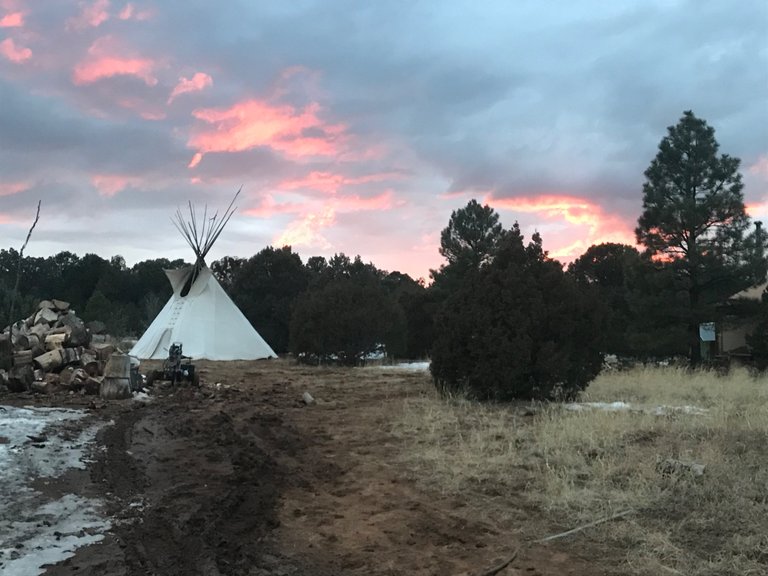
It’s been three weeks now since I left western Montana to make the long 1,100 mile drive south to the small up and coming community I would be staying at for at least the next two weeks to see if it would be a good fit for a longer term stay. It wouldn’t be the first community that I had visited, and I wondered if this would end up being the right one for me, where I’d end up staying longer term. After two video calls and some contemplation, and of course being invited to visit in the hopes it was a good fit, it felt right and I decided to make the trip. After all, it sounded like exactly the type of community I was looking for, everybody here seemed to be on the same page I was, and they were actively looking for new members and desperately in need of someone to help with the countless projects that were already in the works or being planned as a part of the endeavors here to become as independent, self sufficient and sustainable as possible.
At the heart of it all, the community was being built and expanded around the intention of creating a safe haven for freedom lovers seeking to weather the Covid-1984 tyrannical storm that is upon us, and that was certainly one of the key factors drawing me here - the hope of connecting with and helping like-minded freedom-oriented souls build a sustainable, alternative way of life to the tyrannical, technocratic madness currently sweeping the land. The Great Reset aimed at ushering in a brave new technocratic world may be well underway, but there is also a Greater Reset that is sweeping the planet, a movement of individuals coming together to combat the global mandavaxx march of tyranny by actively working to build viable alternatives to the globalist technocratic smart-city society being foisted upon humanity.
If this was an opportunity to more actively become a part of this revolutionary counter-cultural movement, then it would be well worth once again uprooting myself from the place I’ve called home for so many years and making the 1,100 mile drive south, even if it was to a state that had gone much more the way of the Covid tyranny. And if things didn’t work out long term, I’d have all my belongings in my car, fully set up to continue living the camping lifestyle I’d become quite accustomed to over the past two years, and both New Mexico and Arizona boast an abundance of great winter camping opportunities, many of which I’m familiar with from my two years on the road, so if it came to that I wouldn’t have far to drive to find a nice place to pitch my tent and go on living the now familiar, nomadic, off grid camping lifestyle. So after several days of packing and preparation for my travels, I departed a day sooner than I had initially planned in order to miss the frigid temperatures forecasted to sweep through the west, hoping to stay one day ahead of the arctic air so I could comfortably camp every night I was on the road rather than having to pay for hotel rooms to survive the cold.
After three days on the road and two nights at beautiful campsites with only moderately cold overnight lows, I managed to stay ahead of the bitter cold following in my tracks and arrived safe and sound, although tired from the journey, and was welcomed warmly. I would be staying in a 24 foot insulated yurt with a wood stove, which after two years in a tent and several months sharing a house with two families, felt just a little like royal accommodations.
Unbeknownst to me when I departed three days earlier, the timing of my journey couldn’t have been more perfect, as I had not only managed to stay a day ahead of the arctic cold front sweeping south, but the biggest winter storm of the season for these parts also hit just hours after my arrival, a storm that wasn’t yet even being forecasted the night before my departure. It began snowing just before midnight as I was finishing moving in my bags for the night, and by the end of the following day, it had dumped a good 8-10 inches, the next several nights featuring frigid sub-zero temperatures.

I had a wintry welcome to New Mexico, more than a bit surprised that my first nights this far south were actually colder than the coldest the temperatures in western Montana all winter long!
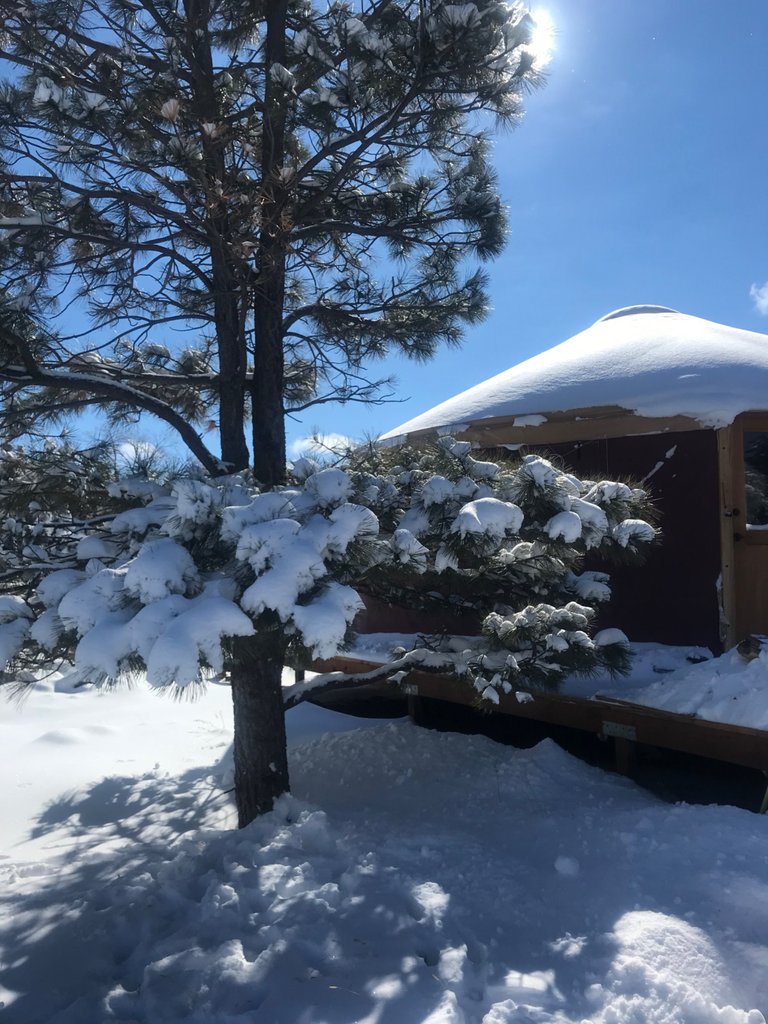
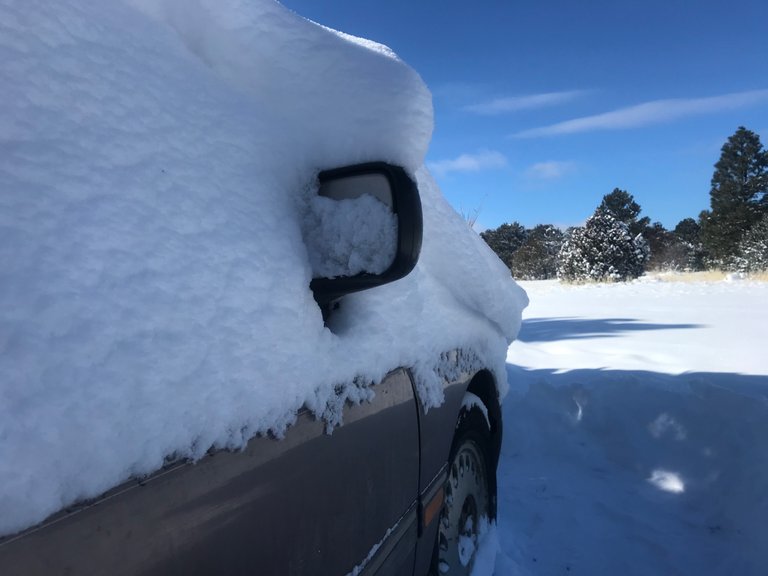
But I was used to the cold, and the wood stove kept the yurt surprisingly warm, easily able to maintain an inside temperature of 70 degrees even with outside temperatures at or below zero, thanks to the superb insulation job that had previously been done.
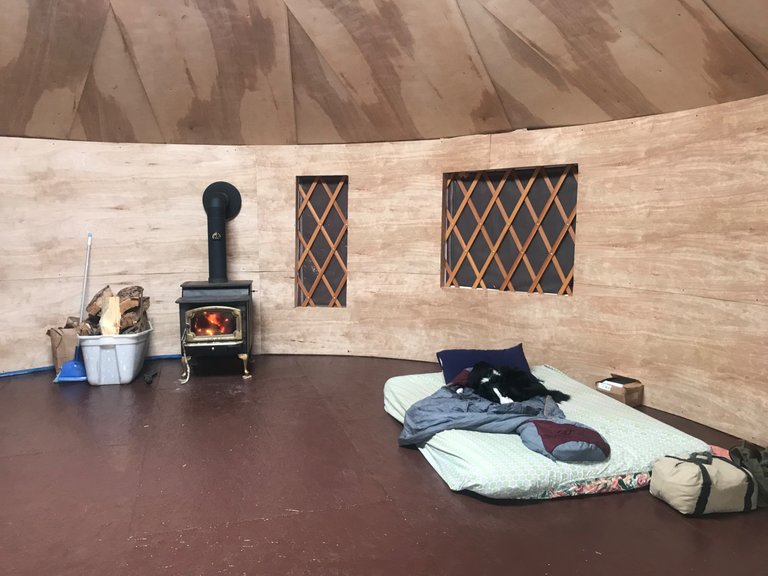
Empty apart from a mattress, the wood stove, composting toilet, a small propane stove/oven and light, in less than a week the yurt was pretty much fully furnished, accomplished as we organized and cleaned out the storage shed, killing two birds with one stone. All that’s really missing now is a bookshelf, which I’ll either be able to make or find a cheap one at a thrift store one of these days, and The latest addition to the decor is a giant cactus in the center of the yurt under the skylight, and all that’s really missing now is a bookshelf, which I’ll either eventually build myself or find a cheap or free one at the thrift store or on Craigslist.
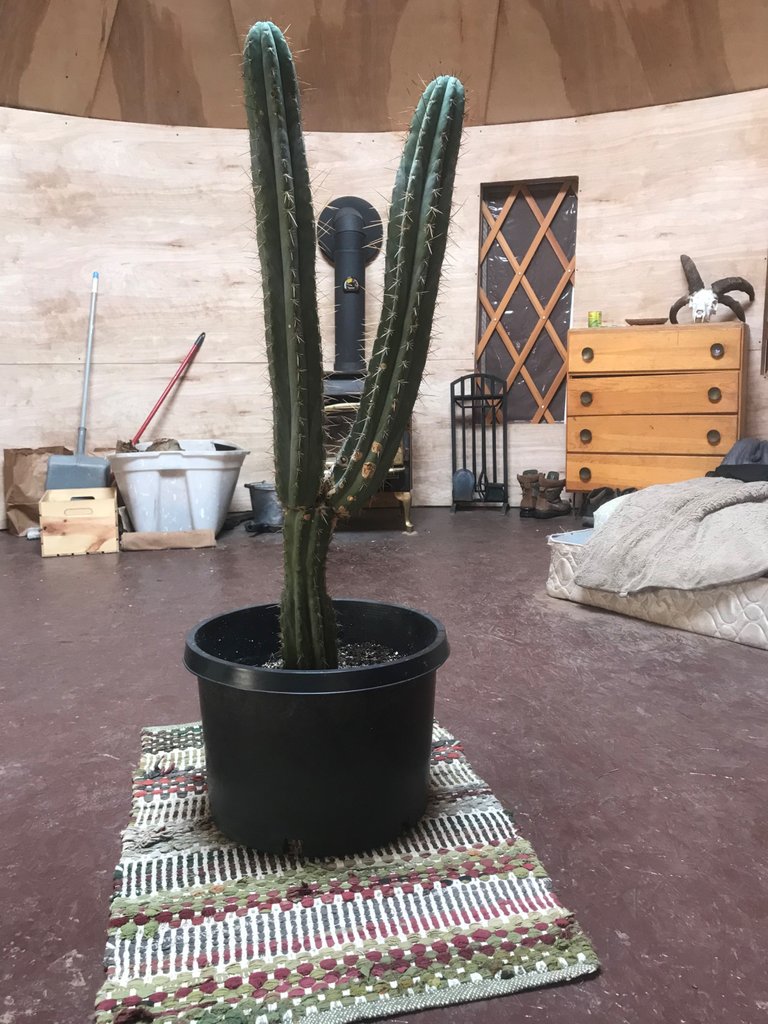
After taking it easy that first snowy day, I’ve stayed plenty busy my whole time here, first shoveling snow, then chopping firewood, learning the ins and outs of living here, and working on plenty of interesting and pretty cool projects.
After settling in to life on the ‘ranch’, as it is commonly called, the weather warmed up to much more seasonable temperatures conducive to outdoor work within a week, and I’ve stayed plenty busy working on a number of outdoor projects ever since - no shortage of work, never a dull moment to be had, and yet still plenty enough free time when I need it.
I haven’t been making any posts since I arrived mostly because I’ve been so busy with the work here and haven’t been particularly inclined to spend my free time researching the craziness going on in the world, rather enjoying a break from the world of news, politics and Covid Clown World, while actively taking part in the creation of an alternative way of life to the increasingly tyrannical and crumbling ‘mainstream’ societal system brought to planet earth by Klaus Schwabb & Co.’s Great Reset. Like Derick Broze, it seems to me to be a far more productive use of energy to ‘exit and build’, by withdrawing ourselves as completely as possible from this failing authoritarian, technocratic societal Matrix system and instead spend our time working to create sustainable alternative solutions to the tyranny - freedom cells, networks of like-minded groups/individuals, and independent, sustainable small communities - rather than continuing on with life as ‘normal’ in the system, hoping conditions will improve while pointing fingers at the problem and perhaps taking to the streets to voice our discontent with the dictatorial technocrats, oligarchs and political puppets who don’t give a damn what the will of the people is, even if it is the will of the majority.
I can’t express how refreshing it was to be able to personally connect with like-minded individuals who are taking direct and meaningful action by investing their time, money and resources into just such an endeavor, and to actively become a part of such a beautiful and important work during my time here, which it now feels like will be a good bit longer than two weeks, but just exactly how long we’ll just have to wait and see… I will say, after over two years on the road and visiting a number of small farms, communities and the like, this is the first place I’ve felt like I could settle down and call home for any extended period of time, so that is a good sign if this is where I’m meant to be for a while.
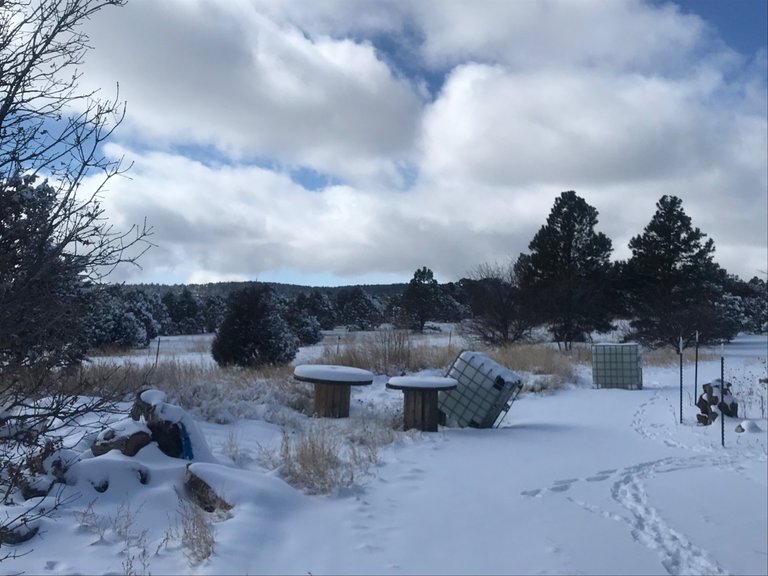
Only 30 minutes from Albuquerque, but high in the Manzanita mountains east of the city, it feels quite secluded for being so close to such a big city, and at a 7,200 foot elevation in the high desert forests, there are plenty of trees for the southwest, relatively mild summers, and an actual winter season that is also quite a bit milder and shorter than those in the northern Rockies, with the snow typically melting off between storms and plenty of sunny days with moderate highs in the 40s and 50s making for great outdoor work weather apart from the mud when the snow melts.
With the Sandia Mountains to the north, and Manzano Mountains extending southward, there is plenty of national forest close by, with easy access to countless trails and forest roads just a few miles away for outdoor recreation, and even a chunk of state land just one vacant 10 acre lot away for quick and easy hiking right out the back door, which is especially great for walking the dogs on busy days, and sports some really nice views.
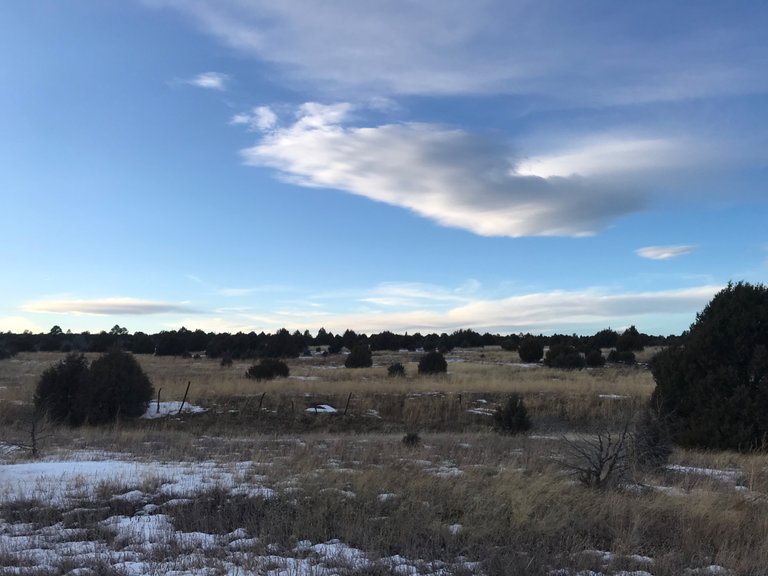
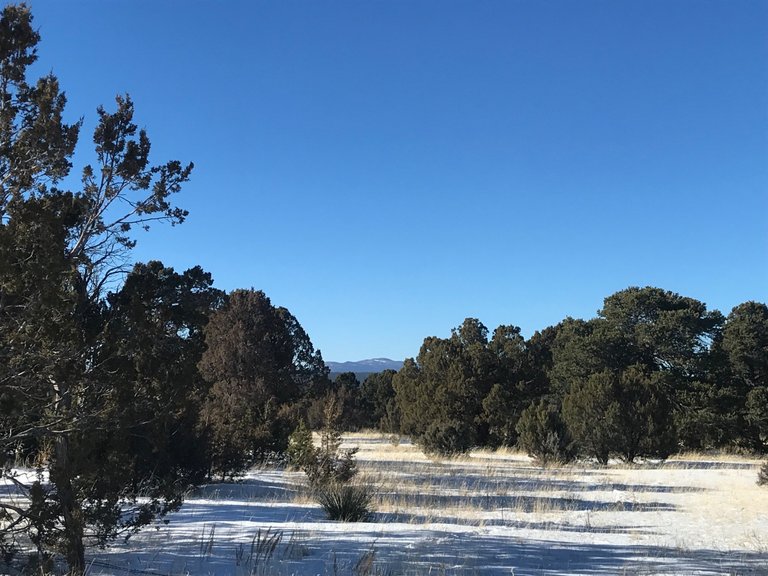
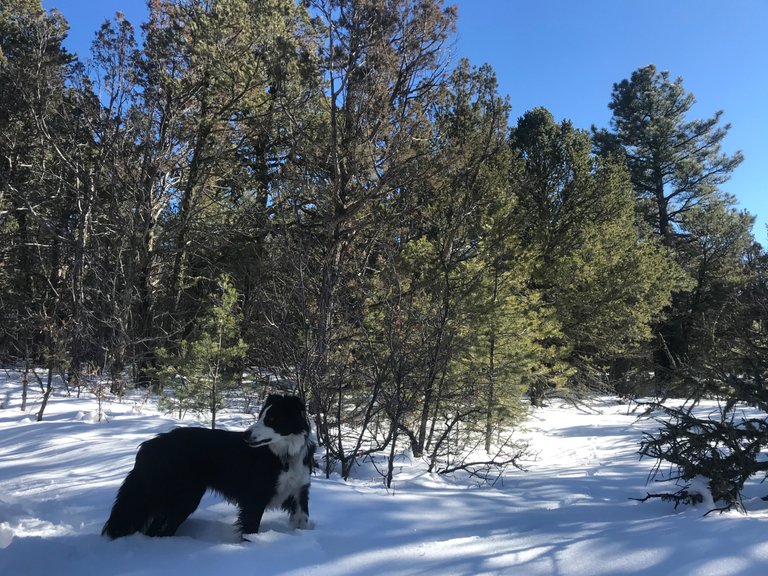
Dakota loves it here, instantly hitting it off with Moonlight, the other dog here, and they keep each other (and the humans) pretty well entertained.
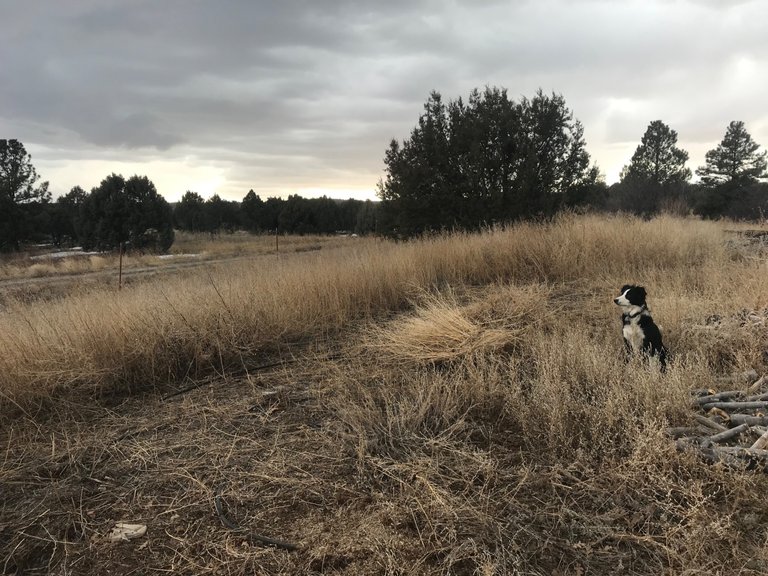
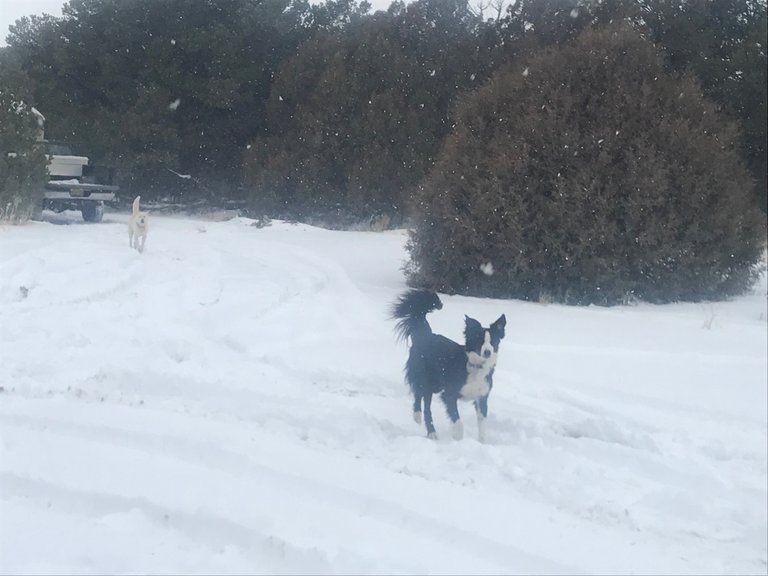
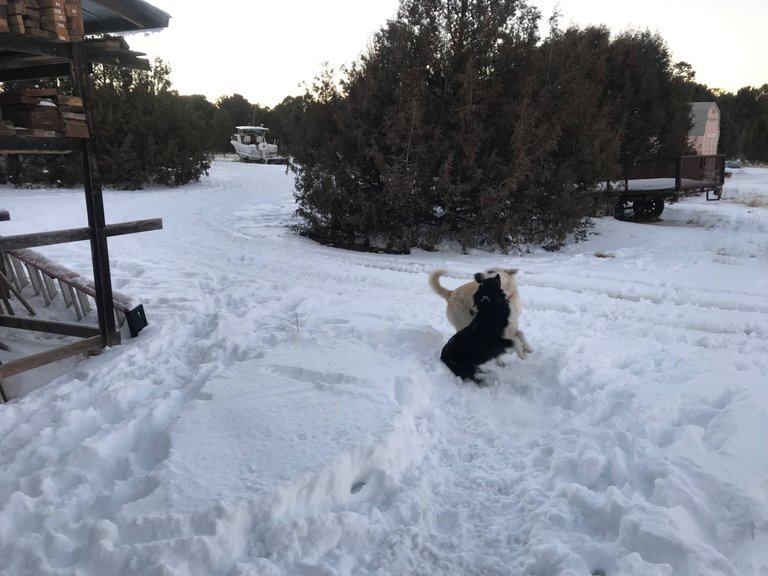
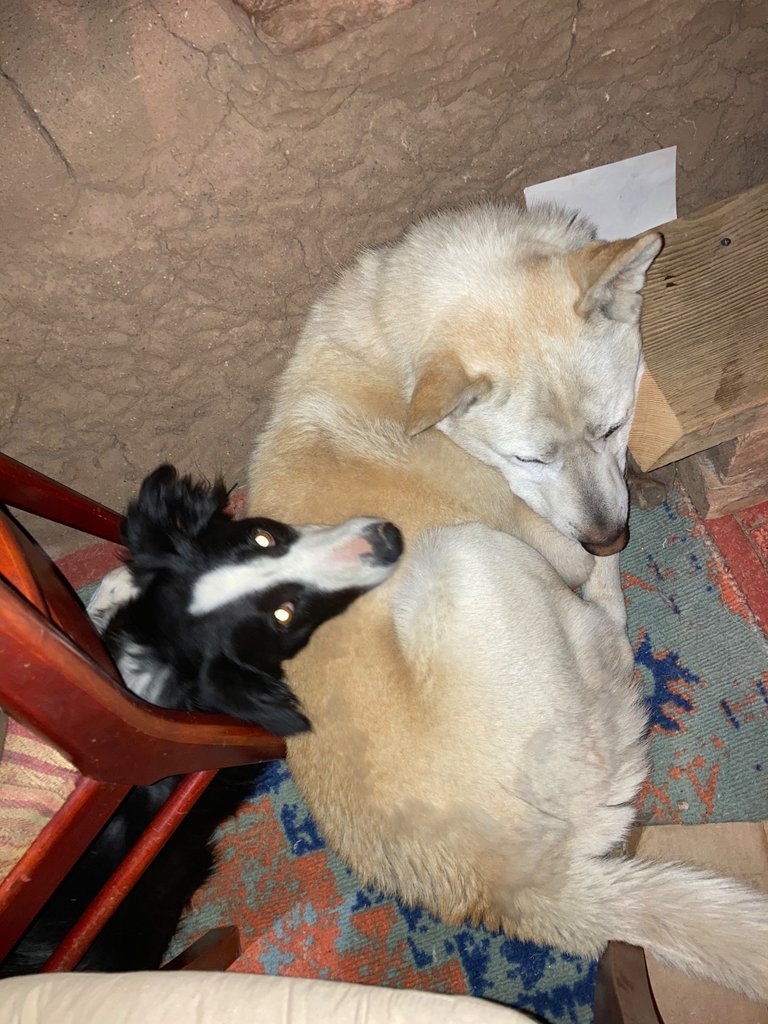
I took my first mountain bike ride with Dakota earlier this week on Monday, hitting up one of the desert trails in the Sandia foothills out Albuquerque’s back door, probably about the only area nearby where the trails are dry enough for biking with all the snow and mud around, but that is one thing the valley deserts tends to be really great for - dry winter recreation, and beautiful desert views…

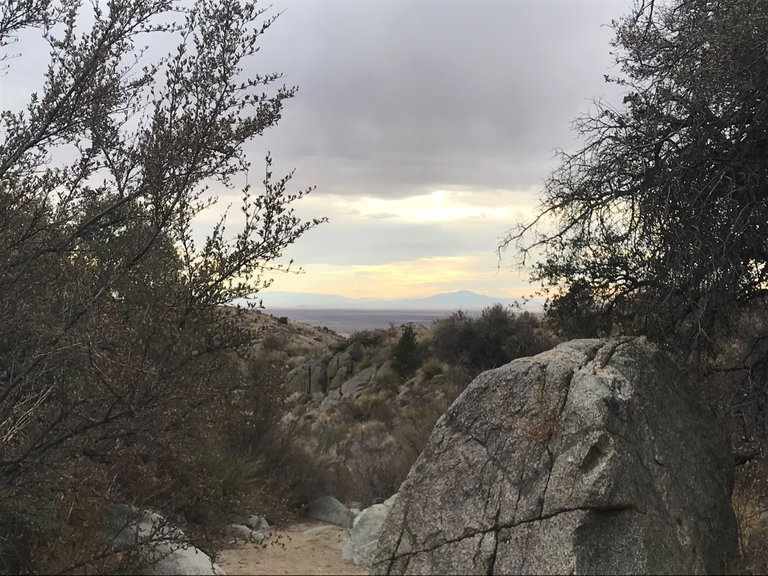
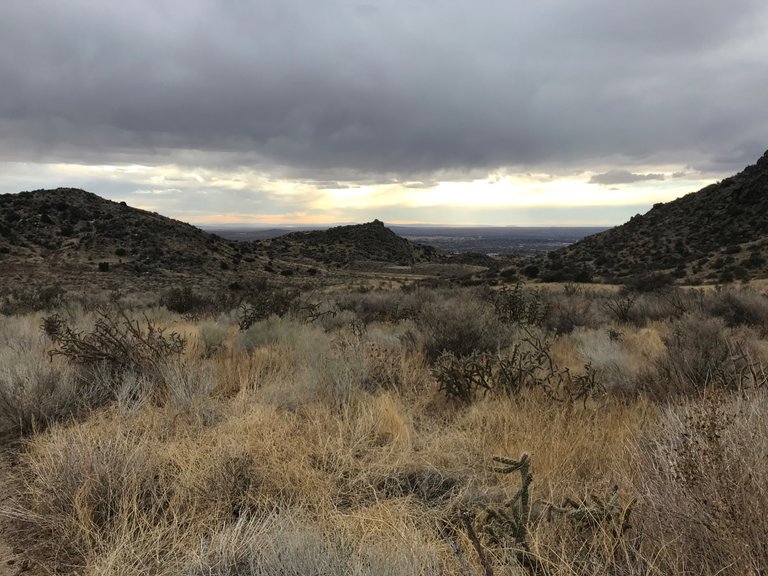
It’s definitely not Montana, but the views up here are still pretty amazing, and the sunsets absolutely stunning. There’s a reason New Mexico is called ‘The Land of Enchantment’, and the amazing southwest scenery surely has something to do with it.
Sunset hike near the property:
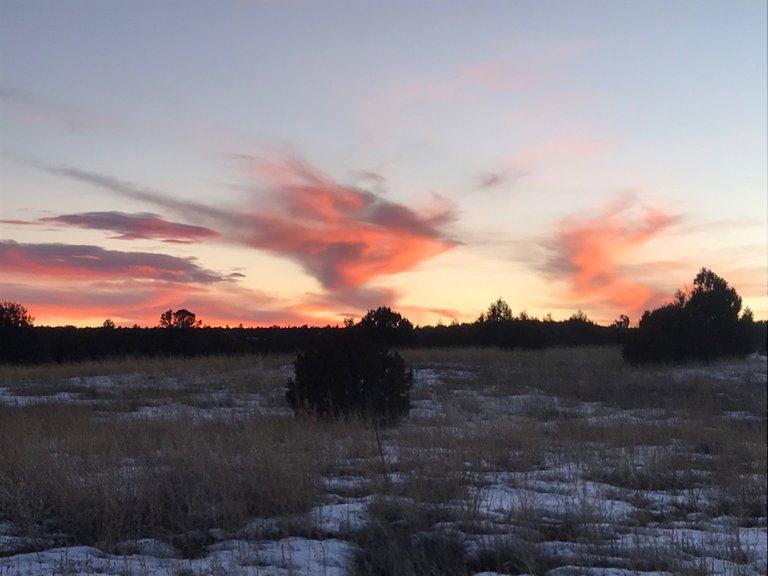
Looking toward the front of the property from the back of my yurt one evening:
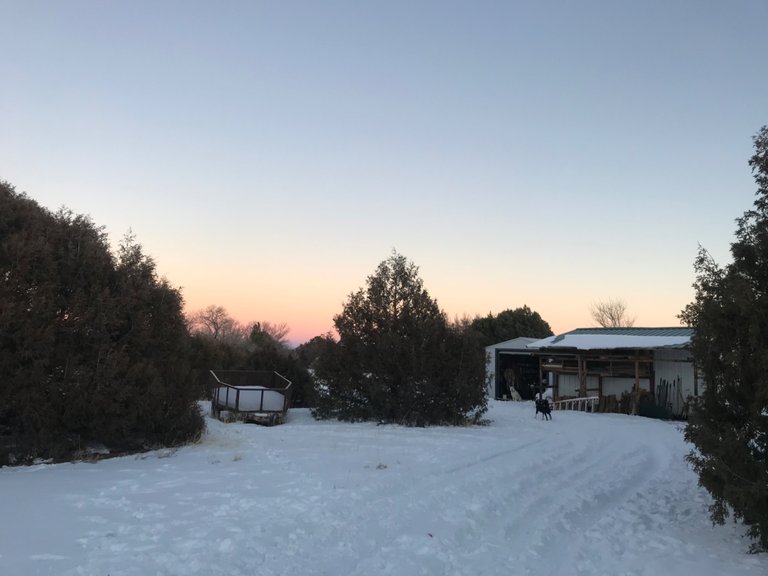
And a stunning sunset view from right out my front door:

As far as daily life here goes, I was really impressed with the number of practical ways true sustainability is being practiced and constantly strived after, and also with the long-term vision for the community, which has clearly already come quite a long way towards fruition from its beginnings. There are currently two yurts, a really nice camper, a smaller camper for guests passing through, as well as the main house and a casita (the Spanish word for ‘small house’), so there is currently more housing than there are community members, with only the main house and two yurts currently in use.
The owner of the land, a really nice French man along with his 10 year old son live in the other bigger yurt, while a single mom and her two young children live in the main house, which also serves as the central community hub, where meals are often shared, drinking water is stored, hot showers can be had, and meetings are often held.
Wood stoves are used for heating all of the main living spaces, with wood stoves also ready to be installed in both campers, which will be one of the next projects we get to, and there is no electric heat used at all. Since the owner also has his own small tree trimming business for cash flow, there is no shortage of firewood, as that business brings in an abundance of good wood, some of which would also be excellent to use for crafting and selling rustic furniture - a potential future business to bring in money for the community once the future wood shop area gets fully set up. With frequent muddy conditions in both winter and monsoon season, wood chips from the free wood also serve to make paths and drives through the property, not a bad substitute for gravel and a whole bunch cheaper if you’ve already got the wood to chip up!
And although there is running water in the two houses, there are only composting toilets used here, and one of my first big projects was to build a new humanure compost bin for the composting toilet system, which was for a short term an ‘emergency’ as the initial humanure bin was getting full to max capacity. That was a lot of fun, and it turned out looking really uniquely rustic, built with the rounded lumber pieces from the outside edges of the milled trees, which are thrown away by the lumber mills or sold for dirt cheap because they aren’t used for traditional framing and woodworking. To me, it sure looks a lot cooler with the natural look of the lumber throwaways than it would using the common straight milled wood, and far cheaper at the same time - a real win-win in my book.
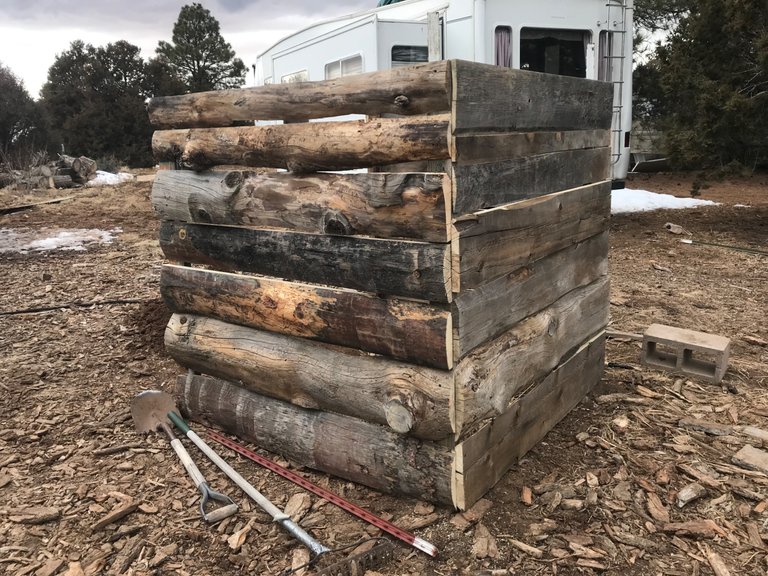
Since I arrived, we were able to find a good source for wood shavings and sawdust for the composting toilets at a lumber mill in Albuquerque run by really nice folks, which are thrown into the composting toilet bucket after each use, and then also get free bags of spent coffee grounds from Starbucks for the same purpose. A thick layer of weeds picked from the property then covers the composting humanure and keeps any pungent smells from escaping, which in two year’s time should be great compost - 1 year to fill the 5x5x5 box and another year to fully compost.

A second box will eventually be constructed, which will be used during the second year while the the first full bin fully composts, which should create a cycle so that every year one bin of compost is harvested and becomes the useable humanure bin for the next year. Then once the original bin composts in a year’s time and is harvested, it will be ripped down and the two larger permanent bins should be all we need from here on out.
There is also a large fenced in garden area complete with compost bins for food waste, and plenty of area to expand outdoor gardening space, which I hope to help out with as I love gardening, and like the others here am also pretty passionate about food sustainability, especially during these interesting and ever changing times. And to grow anywhere near the majority of your own food, especially in an expanding community, you’ve got to have a pretty big garden (and time to do a lot of canning in the fall, as I saw firsthand during my time at a homestead in Washington)! A large underground greenhouse should also eventually enable year round gardening and the ability to keep a number of warmer climate fruit trees, and is one of the next really big projects in the works, which once complete and combined with produce from the outdoor gardens should get the community well on its way towards true food sustainability, as well as open up more living space in two shipping container houses built into the elaborate greenhouse plan. It is no doubt a project that will be done step by step over many months, and building the attached root cellar will probably be one of the first steps, to give us more food storage space for the coming season’s harvest.
In the meantime, getting off-grid solar set up for energy independence and security is the top priority of the big projects, and already in the works, with the actual installation of the solar system probably not too many weeks off now. New Mexico is also one of the best states in the country for full-sun hours, great for solar power, and once the solar is setup, water access (electric well pump), frozen food storage and the like should all be secure during power outages or even if we were to be entirely cut off from the grid, and will cut the power bill down significantly, ideally pretty much down to zero.
As far as food sustainability goes, like so much of rural America, this particular area seems to be a great place for food independence, not only due to a longer grow season and more sun compared to the north, but also because there are a number of locals nearby from which to purchase or trade for eggs, goats milk/cheese/yogurt, humanely raised grass fed beef for those who eat meat, and more, including fresh produce in the summer.
Plus, as it turns out, the folks here also had plans to raise a small flock of chickens for eggs, and had found a good deal on a small shed to be used for the chicken coop, which only needed to be moved to the designated location before it could be put to use, so they were excited to hear that I was experienced and knowledgeable when it comes to chickens, from all my time raising and caring for the flock of chickens I had in Montana for several years. When I heard that they wanted chickens here but had held off due to a lack of experience and free time to do the research needed to be ready for the endeavor, but were already working on getting a coop set up to be ready when the day arrived they were ready, and with chick season just around the corner, I offered to raise the baby chicks in a brooder in my yurt for the first 4-8 weeks until they get old enough to go outside in the coop if they wanted.
Taking me up on the offer, one of my first projects was to then to build a suitable brooder, as baby chicks need to be kept in a small, well heated space for at least their first month of life if not raised naturally by a mother hen who would otherwise keep them warm enough until they grow their feathers, from 95 degrees during their first week of life steadily dropping down to 70 degrees at 6 weeks of age, around which time they can be transitioned to normal spring temperatures and kept in a non-heated coop and from there be introduced to the outdoors.
The best candidate for a brooder seemed to be a large wire dog crate, so as soon as there wasn’t any other urgent work needing to be done, I set out to find enough scrap wood pieces to form solid walls around the crate and build a make-shift brooder. A day later the project was complete, and although not exactly aesthetic to the eye, there was zero cost for construction and it should make a great functional brooder for a month or so, with a heat lamp providing the necessary heat to maintain the proper temperature inside. The free wood shavings picked up from the local lumber mill are perfect for bedding and will save us money on pine shavings, and we can pick up more anytime we are in town, so that is a great connection we are blessed to have found. Then with a few minutes of free time to get it moved from the shop and all set up in my yurt, and a day to pickup supplies - red heat lamp bulbs, chick food, feeders and waterers - and it is fully functional and ready to go; this week I tested brooder temperatures under the lamp mounted at several different heights and it has no problem staying warm enough, so it’s all ready to be filled with baby chicks!
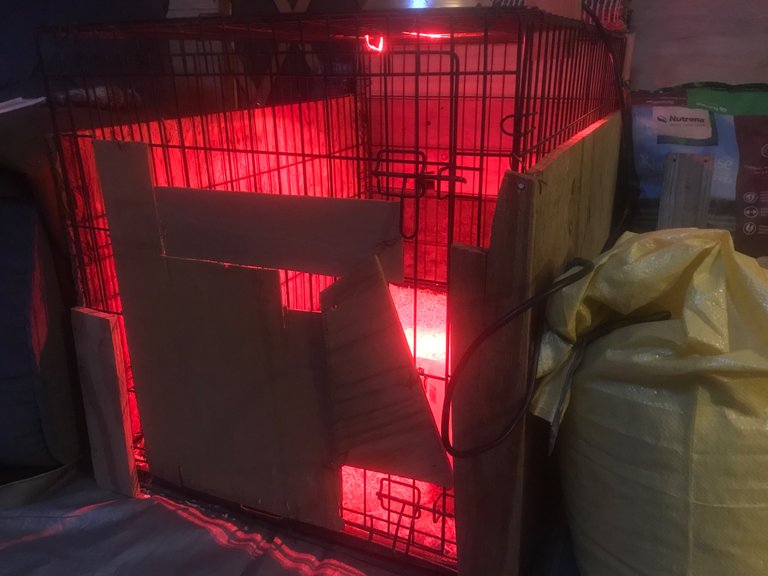
Local feed stores in the small country town 25 minutes away have or will soon be getting chicks in for sale, and by the first week of March they should be in all the feed stores, hopefully giving us a decent selection of breeds to choose from. In the meantime, with the end of the month fast approaching and tentative plans to get chicks the first week of March, it’s full speed ahead on transforming the shed into a functional chicken coop. With the help of a Bobcat, the shed was moved to its final destination, and upon completion of the first big composting bin, work on the chicken coop could begin. Eventually there will be a large fenced in outdoor run, with the back side of the humanure composting bins separated by a storage box for composting toilet materials forming a large part of the fence line in the front, but the first priority is to finish the coop as the chicks can eventually be moved to the coop without needed to be let outdoors if the coop project gets behind schedule.
So far I’ve installed two of the three windows that will be put in, and then the top sections of several 5 gallon buckets will form additional ventilation windows, inserted into sized cutouts in the walls and covered with hardwire to keep predators out - and then all we have to do when we want to close the vents to keep moisture or cold out is simply pop the lids onto the top of the buckets which will be facing out and extending a few inches outside the wall. Sounds easier than building hinged wooden windows, and like a pretty cool way to upcycle a few 5 gallon buckets that the owner can currently get for free from a connection of his. It wasn’t my idea, but I like it, and we may just feature the world’s first chicken coop featuring a plastic bucket ventilation system. Then install some linoleum on the floor for easy cleanup, insulate it, put up a few roost bars, build the nesting boxes and a small chicken door, and eventually re-paint the exterior, and coop will be completed.
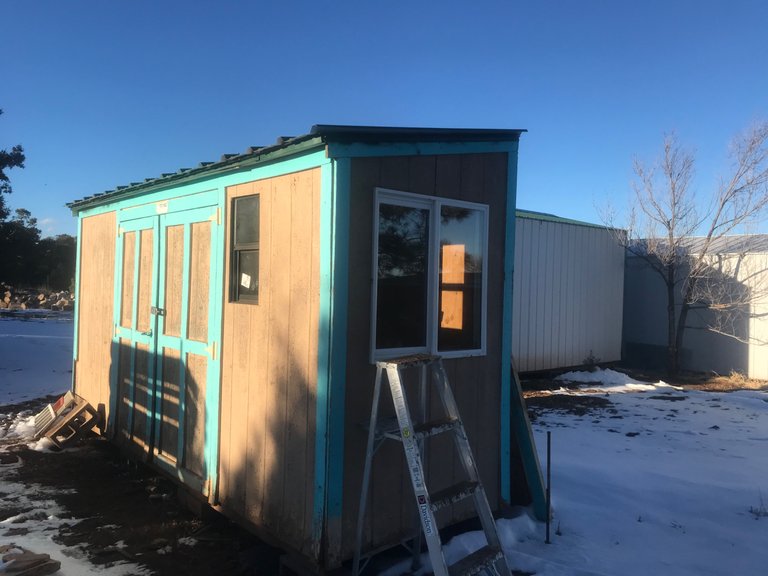
It’s a project I’m finding quite enjoyable, and it’s moving along pretty quickly, the goal being to use almost exclusively reclaimed wood and building materials from previous projects, and it actually looks like we’ll be able to do so for just about everything but maybe the linoleum. It may take a bit more time, but with the price of lumber and amount of useable construction materials that end up in landfills, it seems to be worth the effort to sift through building scraps, dis-assemble pallets for the wood, and pull nails from previously used 2x4s rather than buying new lumber; and since there’s plenty of useable wood to reclaim for the project, that’s exactly what I’ve been doing, and if all goes well, we may not have to purchase or use a single new piece of lumber for the entire chicken coop!
One major aspect of life in the southwest I’m not so used to is not having the abundance of water that comes with life in the northwest or in other wetter climates like the Ozarks. Despite being in the forested mountains, we are still in the desert here and so water conservation is of utmost importance to being truly sustainable and self sufficient, and rainwater catchment is one of the main features here.
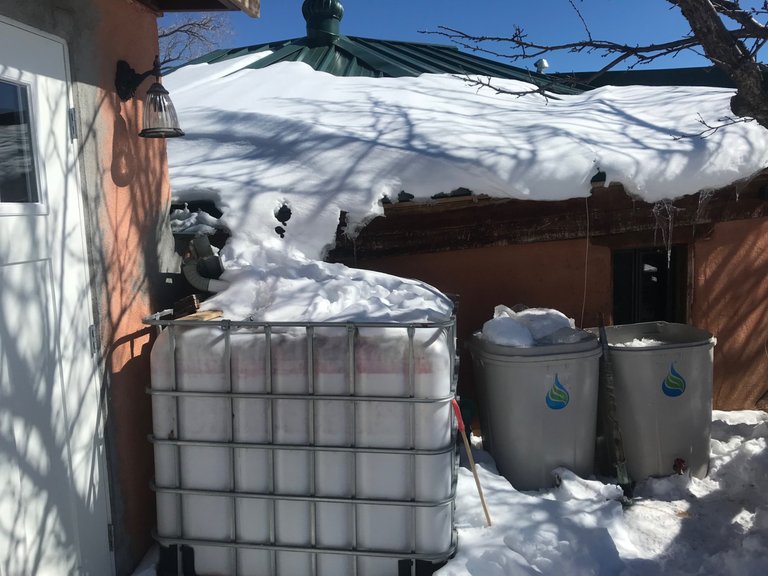
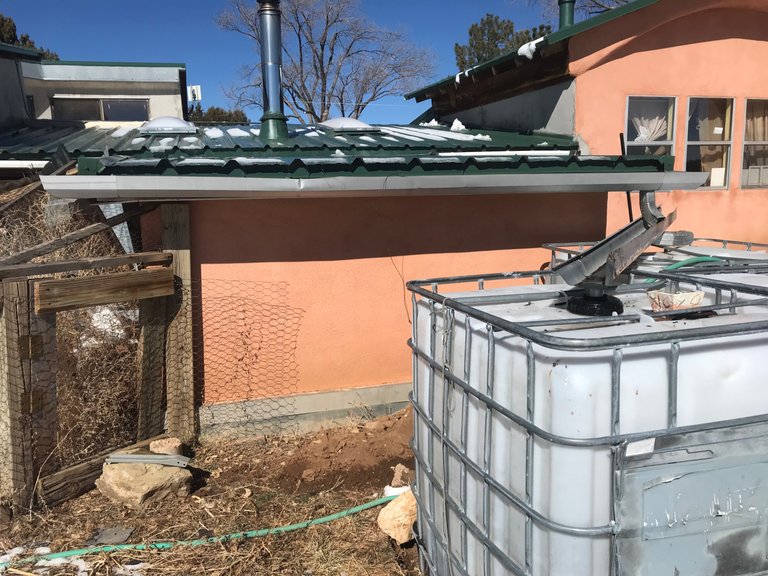
Amazingly, as I was informed, last year’s garden was watered exclusively with rainwater, while the well water is currently only used for drinking water, with the long-term plan being to hookup the plumbing to a 6,500 gallon cistern, which will eventually be buried to prevent freezing and serve to collect all of the rainwater from a number of the main buildings funneled into it. In the meantime there are a number of smaller tanks in a wide range of sizes used to catch water from the snow melt, and I was blown away by just how much water one single snowstorm could supply.
All of the used water from dishes is saved, and then goes to water trees or clean out the composting toilet buckets when they get full. Only the showers and laundry water actually drains into the septic tank, and clothes are dried by the sun rather than a power-sucking drier, so there’s a pretty good water and energy conservation system they’ve got going on here. And every time I shovel snow, the idea came to me to make sure to shovel as much as possible around the base of nearby trees to get them the extra water and boost their growth (or help them recover from the stress of previous droughts). Hopefully they appreciate the love :)
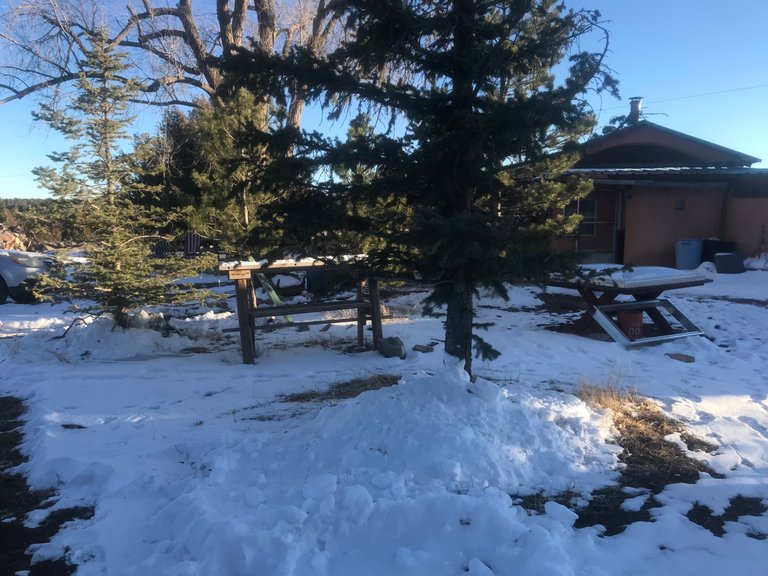
In the yurts and campers which aren’t hooked up to the plumbing, rainwater is fetched from any of the catchment tanks that are full, and then used for dishes, cleaning, water for the animals and the like. I personally just use my 7 gallon camping water carrier which has a spigot and functions just like running tap water, with a basin underneath to catch any used water. Water carriers mounted on ceramic crocks with spigots are used for the drinking water, and so despite having no ‘running water’ in the yurt, I have two taps that give me running water on demand - one for drinking water and one for everything else - with only the slight inconvenience of having to re-fill the water every week or so, and an abundance of rainwater literally right out my front door now, thanks to the first yurt improvement projects I completed.
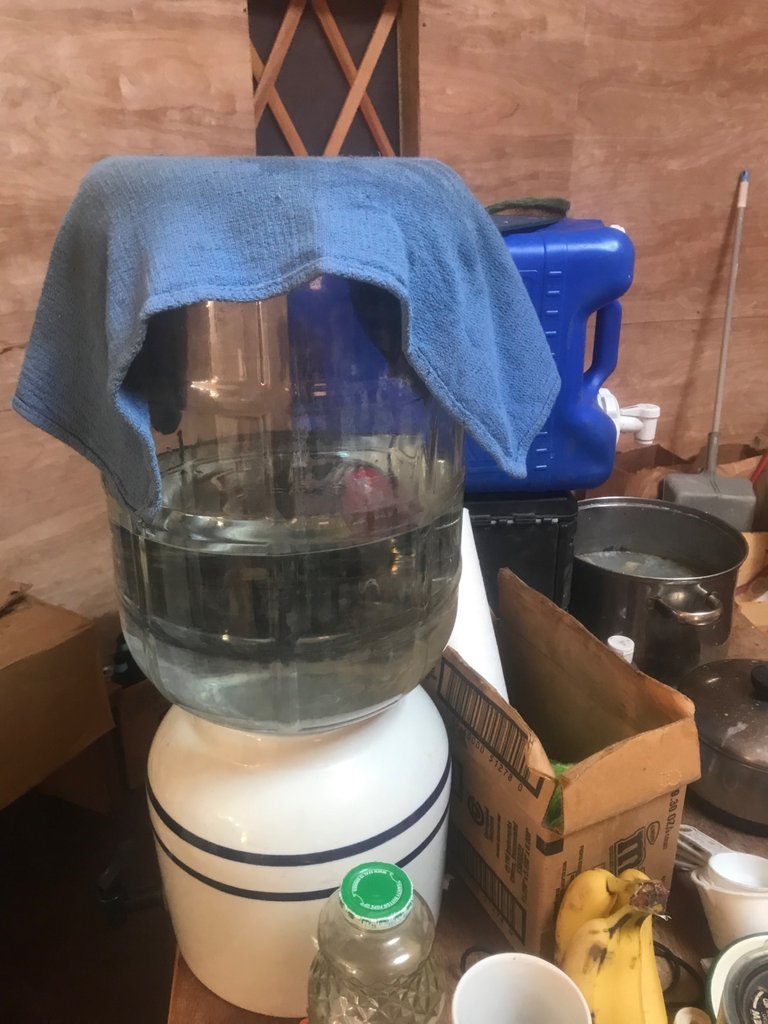
One of my first projects here was to set up a small rainwater catchment system for my yurt, since it already had gutters built into it that simply needed to be properly set up by placing PVC pipes inside to hold the fabric up to form the gutter shape. Then all I had to do was chip the ice out of a mostly empty rainwater catchment barrel, actually an old recycled 55 gallon oil barrel with a spigot on the bottom and screen on top, and then setup the empty barrel under the rainwater drain. Not an easy task, but I got all the ice out without damaging the barrel. Then, after repairing the small crack it had so that it would be watertight when full, I set it on a large round of wood on top of two cinder blocks to get it high enough off the ground to be able to easily fill empty buckets from the spigot and have the top close to the falling rainwater, in order to prevent water loss on the windy days, as high winds here are not infrequent. With a little ingenuity and a good day’s work, I now had a brand new functional rainwater catchment system which was put to use immediately, straight away catching the remnants of the snow melt from the big snowstorm that welcomed me, and although the snow was already entirely melted off of at least half the roof, I still caught about 50 gallons from that snow melt alone, and another 50 gallons from the next snowstorm several days ago (and about 20 gallons so far from last night’s little dump).
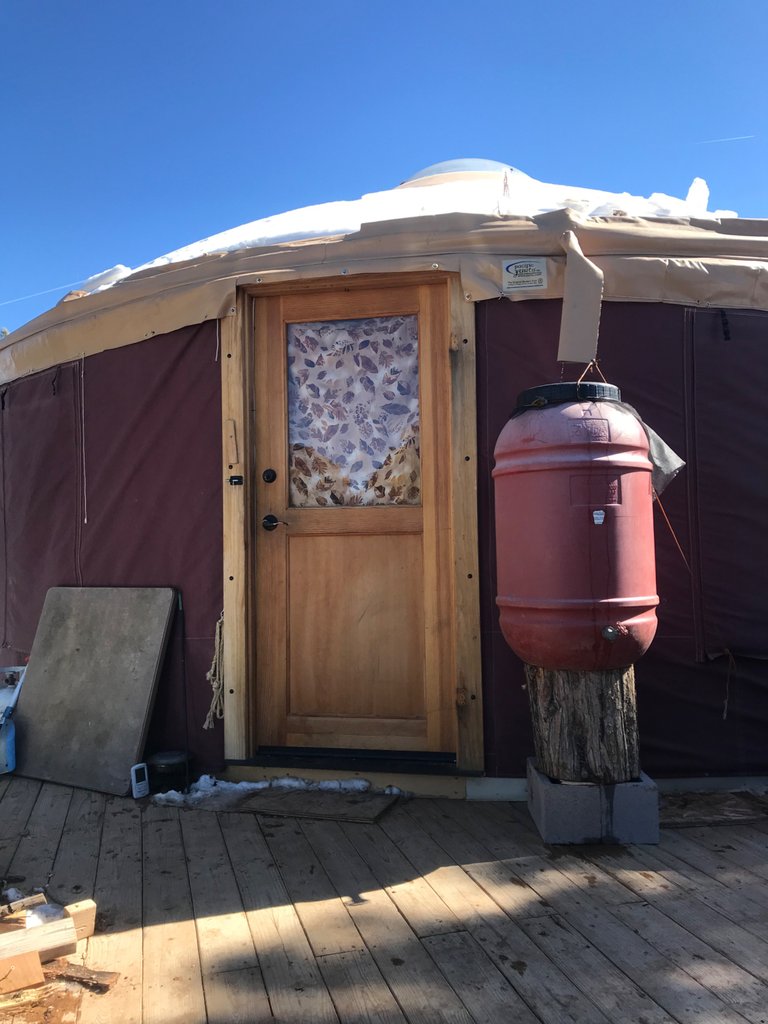
With a shortage of unused larger barrels, I decided to just stack a couple of rounds below the second rainwater drain in the back of the yurt and simply catch the water with a 5 gallon bucket, which then needs to be swapped out fairly often when the snowmelt is at its peak, but it does the trick and I’ve already lost count of the total number of 5 gallon buckets I’ve filled up back there in just three winter storms, but according to my calculations I’ve caught about 75 total gallons in those three storms alone, with about 80 gallons caught off the back roof of the main house from just the last two storms…
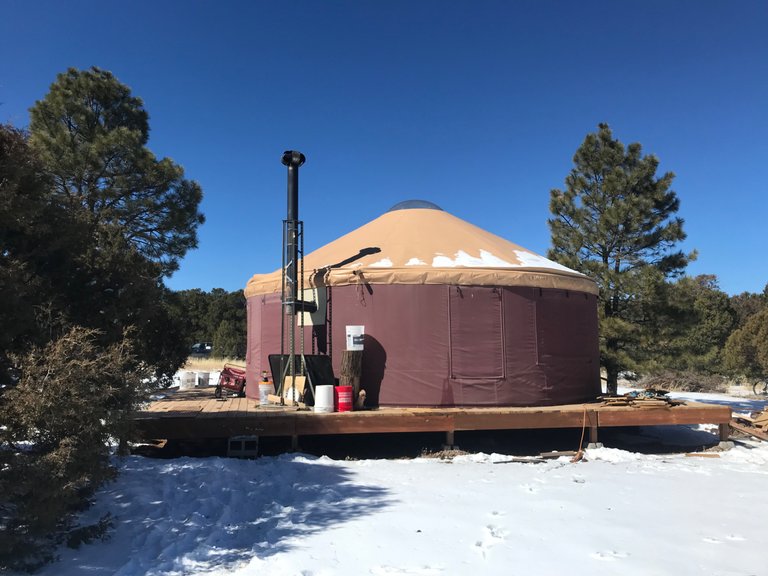
Even in the desert, it turns out, the biggest problem with rainwater catchment as a main water supply isn’t the amount of water that can be caught when the precipitation comes, it’s having enough storage for it all so there’s enough to last through the dry months. I was shocked that less than two snowstorms worth of snow melt from a relatively small 24 foot roof was already overflowing my 55 gallon barrel which is only catching about half of the total water coming off the roof. So not only do I now have a full 55 gallon barrel of rainwater at my disposal, which sure beats carrying 5 gallon buckets back from the main house whenever I need more wash water like I did one time, but I’ve also got a number of 5 gallon buckets full of water being used to store all of the excess. Whenever the big barrel starts to overflow, I just drain 5 or 10 gallons into 5 gallon buckets, and then if need be, dump the extra water into bigger tanks that aren’t currently full, freeing up the buckets for more water when the snow or rains return again.
Plenty to stay busy with, even on days it’s too cold to do much work on outdoor projects, but today was an obligatory day off to head into the city and join all of the freedom lovers welcoming and supporting all the truckers of the People’s Convoy as it drove through Albuquerque on its way from California to DC, already big and getting bigger as truckers and supporters continue to join the convoy as it moves slowly east towards the capital. That was a refreshing change of pace and a lot of fun, the support for the resistance surprisingly strong, with more details and coverage of the experience in a coming post dedicated exclusively to that.
After two relatively slow days due to the recent cold and another day spent supporting those taking direct action to stand up for our freedom, it’ll feel good to get back to work on the chicken coop and other projects over the next couple days, as the weather warms right back up, forecasted to be as warm as 60 degrees by Wednesday!
Never a dull moment since I arrived, and that’s one thing that’s not bound to change for as long as I’m here. My three short weeks here have already been quite the experience, and with a sweat lodge held here every month, chicks on the way, gardening season right around the corner, and an endless list of cool projects to work on, it’s an experience that’s fast expanding every day.
Even if it is quite a bit more work, it all feels much more natural living this simple and much more natural way of life - one that features rainwater catchment, composting toilets, wood stoves, gardening, and community life, as opposed to complete dependence (and enslavement) to the totally non-sustainable, unnatural, and increasingly oppressive insanity that modern materialistic western society has become. While it may not be the lifestyle for everyone, it is most certainly the way of life for me, and while the future remains unknown, it would seem that for the time being I have found a place to call home, for however long that may be.
And hey, if you feel like this could be the life for you, we just so happen to be currently looking for new members to fill the vacant living spaces, so feel free to check out the Facebook ad currently up which includes some really nice summer pictures as well: https://m.facebook.com/groups/CCCIntentionalCommunities/permalink/1767332920137678/?m_entstream_source=group
Hope you enjoyed the post, and stay tuned for updates and coverage of the state of the world as I begin to post more frequently again as I am able.
Thank you for sharing this amazing post on HIVE!
Your content got selected by our fellow curator @kaerpediem & you just received a little thank you via an upvote from our non-profit curation initiative!
You will be featured in one of our recurring curation compilations and on our pinterest boards! Both are aiming to offer you a stage to widen your audience within and outside of the DIY scene of hive.
Join the official DIYHub community on HIVE and show us more of your amazing work and feel free to connect with us and other DIYers via our discord server: https://discord.gg/mY5uCfQ !
If you want to support our goal to motivate other DIY/art/music/homesteading/... creators just delegate to us and earn 100% of your curation rewards!
Stay creative & hive on!
Nice, not too far from where I am.
Please consider claiming EverGreenCoin for all of the different sustainable things you do. Just share photos and stories learn more here. https://evergreencoin.org/poe/
Thanks for doing good for the Earth.
Congratulations @jasonliberty! You received a personal badge!
You can view your badges on your board and compare yourself to others in the Ranking
Support the HiveBuzz project. Vote for our proposal!
I really love it! it sells a bit of the dream ;)
I'm glad you seem to have found a home that has in turn found you.
Thanks!